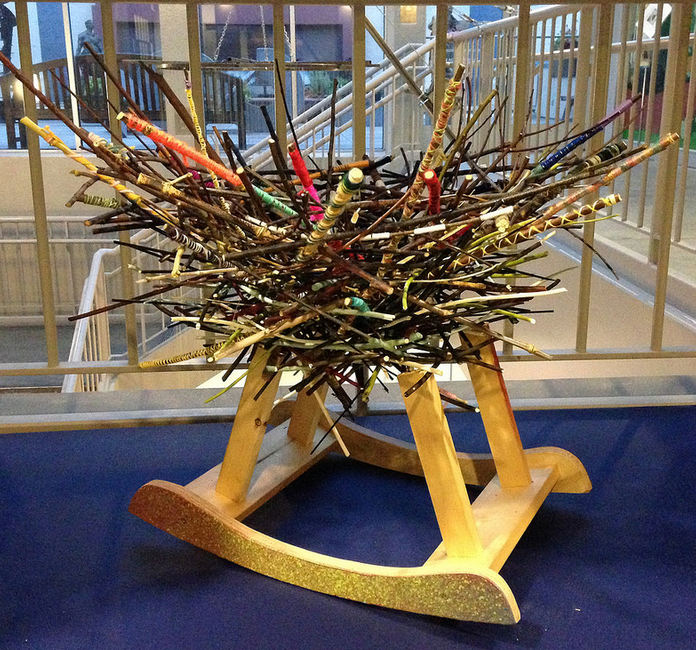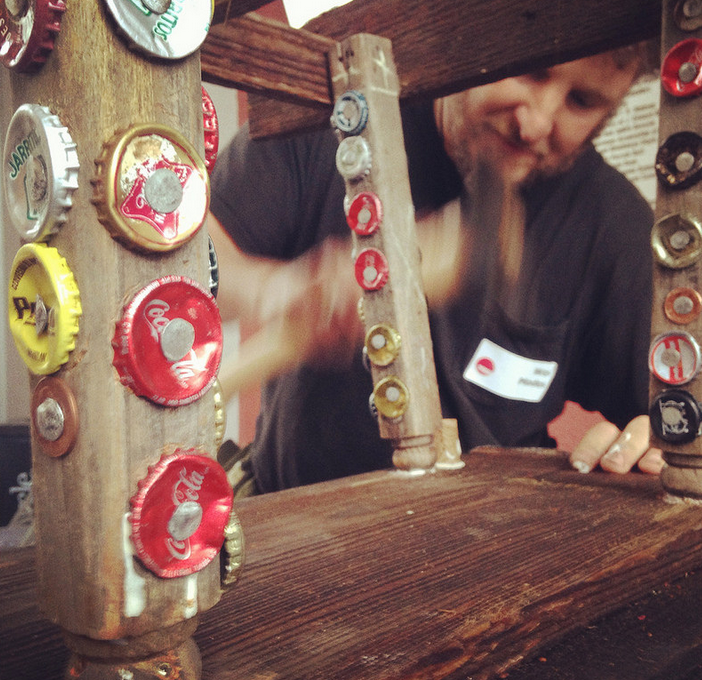The Artists Behind The Cradle Project
 There are over 500 artists behind The Cradle Project. At each exhibit, we invite local artists to make a cradle, expanding the exhibit, and the community around it. The new cradles, ideas, and people who become a part of The Cradle Project become a part of the impact it makes.
There are over 500 artists behind The Cradle Project. At each exhibit, we invite local artists to make a cradle, expanding the exhibit, and the community around it. The new cradles, ideas, and people who become a part of The Cradle Project become a part of the impact it makes.
The reality of HIV and poverty in Africa is less and less visible in the U.S. and the cradles bring it back into our minds in a way only art can, creating that emotional connection and inspiration. It’s powerful to watch artists make meaning of the cradles and the 48 million children orphaned by disease and poverty they represent.
 We’re in the final days of the Santa Cruz exhibit at the Museum of Art and History (MAH). Three Santa Cruz artists contributed cradles during this show: Luke Wilson, Heidi Cramer, and Wes Modes. At this exhibit, the MAH invited museum visitors to collaborate with the artists to create community cradles. On a rainy Saturday the museum lobby was filled with children and families where they got their hands dirty working with adobe for the Endangered Seeds: The Earth as Cradle with Heidi, wrapped yarn around twigs for the Rockingnest Cradle with Luke and hammered together pieces for a traditional cradle with Wes.
We’re in the final days of the Santa Cruz exhibit at the Museum of Art and History (MAH). Three Santa Cruz artists contributed cradles during this show: Luke Wilson, Heidi Cramer, and Wes Modes. At this exhibit, the MAH invited museum visitors to collaborate with the artists to create community cradles. On a rainy Saturday the museum lobby was filled with children and families where they got their hands dirty working with adobe for the Endangered Seeds: The Earth as Cradle with Heidi, wrapped yarn around twigs for the Rockingnest Cradle with Luke and hammered together pieces for a traditional cradle with Wes.
The loudest station in the lobby was right in the middle were Wes had everyone hammering, sawing, and gluing the pieces they found in his barrel onto cradle legs, handles, and the body of the cradle itself. There were a lot of laughs from kids, parents, and everyone else who stopped by to nail a bottle cap into a cradle leg or attach a new piece to the side of the cradle. It was a lot of fun.
“I’d introduce myself to parents then focus on the kids, who were into it.” Wes told me when I sat down with him shortly after the workshop. “Eight year old girls who hadn’t handled tools before were doing it for themselves.”
The cradle Wes made is a traditional cradle made from found and discarded materials like all the cradles in The Cradle Project. “I deal with reclaimed and recycled materials in my art so the concept was familiar to me. My favorite places are the dump and woodpiles. I’m right now building a shanty boat so it’s perfectly natural for me to go into the back yard and see what I find. [For the cradle] I saw an old fruit box and some sheet metal. I didn’t know I was going to make a traditional cradle until I saw the fruit box.”
Sheet metal and bottle caps might not bring a traditional cradle to mind. As Wes talked more about his cradle and the ideas that led to it, he said, “I kind of like the idea of a dangerous cradle. Keeping with the theme of childhood being a particularly vulnerable time with war and disease. It made the risk more prominent. We all take risks for what we need to do and we all take responsibility for what we need to overcome.”
All the cradles are distinct and seeing each artist’s response to the open call to create a cradle is part of what makes the exhibit so relevant to our conversations about childhood, disease, and poverty today. When Wes Modes saw The Cradle Project, he commented on the range of cradles, “A lot of the cradles surprised me in how non-literal they are; almost lyrical. I was actually inspired by that.”
Many of the cradles were sold as part of the original 2008 exhibit to benefit Firelight and the African communities we support who are responding to the needs of children and families. Twenty-two cradles from the original installation are part of the traveling exhibit. At each showing, select cradles are available for purchase. This May, nearly 25 cradles will be available for purchase in San Francisco including the cradles made in Santa Cruz. All proceeds benefit Firelight and the African communities we support.
I asked Wes about the collaborative process and how he feels about his finished cradle that’s now on display at the MAH. “It surprised me, in terms of how it came together as a piece. I love that it’s still prominently a fruitbox. [At the workshop] I felt something was missing. Some kids suggested things but I said, ‘thanks kids, I think it’s mostly done.’ Then a seven year old boy found a pulley in the barrel and said, ‘I think this needs to be on the side.’ I thought, of course. He was right. He helped me attach it to the side. So you could rock the cradle from a distance.”
The Cradle Project at the Santa Cruz Museum of Art and History closes on Monday. It travels to San Francisco next where around 20 San Francisco artists will be making more cradles for the exhibit. The show runs from April 17-May 24th at Alter Space.
As I wrapped up my conversation with Wes Modes, he had some great closing words that I’ll use to wrap up this blog post too, “I like people who take their play very seriously. And who treat serious things very playfully.”
Subscribe to The Cradle Project and stay informed on artists, exhibits, and current news.



